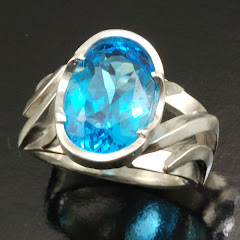
Quartz comes in many types used for jewelry making. Many of the most popular types go by a different name, lending confusion to the buying process for many people. The second most abundant mineral on earth, quartz is one of the more affordable gem options, and it remains popular in silver and gold applications. Faceted, it makes a brilliant stone in many different colors. We use quite a bit of quartz for our jewelry, and appreciate it for its hardness, vibrant color (or lack thereof), and affordability. Following are some of the varieties that you commonly come accross:
Amethyst: This is the beautiful violet quartz that comes in many different shades. Amethyst is the birthstone of February. The most valueable amethyst is deep Siberian or deep Russian, and has a deep purple with red hues. Amethyst used to be as valueable as rubies or sapphires but large finds have dropped the price to what it is today. Green quartz is often called green amethyst.
Citrine: The November birthstone citrine ranges in color from clear yellow to reddish brown. They occur in nature but are most often heat treated amethyst. Often mistaken for the more expensive pure topaz, the citrine offers a more affordable option for a beautiful yellow or orange faceted gem.
Carnelian: Translucent reddish brown quartz with a slightly softer composition. Beautiful with light shining through it to highlight the deep color.
Onyx: Onyx is a type of agate that comes in many different colors, often with different color bands running through. Usually polished and formed into smooth cabochons to show off the various colors.
Smokey Quartz: Can be yellowish, but usually brown to black.
In addition to the above varieties, included in the quartz family are the agate, aventurine, and others that we'll save for another time. The most common stones we use here are the amethyst, green amethyst, and the citrine, though others make an appearance when the mood strikes and we find good specimens. We just got in a dendritic agate that looks like a traditional Asian painting. A clear stone with rusty spots, white, and black “trees.” We love the variety available to us with quartz.






No comments:
Post a Comment